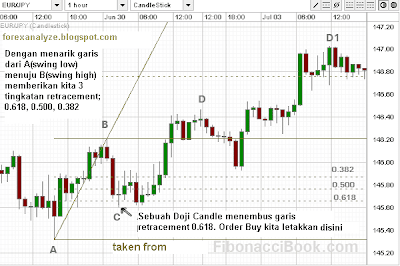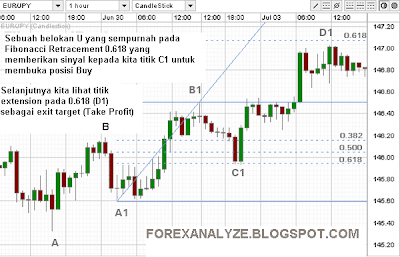Forex Fibonacci
Leonardo Fibonacci is a famous Italian mathematician, founder of a simple series of numbers that refer to ratios valid for natural proportions of things on the planet. These ratios appear from the next numbers: 0, 1, 1, 2, 3, 5, 8, 13, 21, 34, 55, 89, 144, 233, ..., and found while performing next calculations: 1+2=3, 2+3=5, 3+5=8 etc.
If to measure the ratio of any number to one of the next higher number the result will be 0.618. For example, 21/34=0.618.
If to measure the ratio between alternate numbers we will get 0.382. For example, 13/34 = 0.382.
These proportions can be found in nature, science, architecture, music, art. A few examples of Fibonacci numbers are pine cones, sunflowers, pineapples, palm trees, spider webs, snail shells, DNA molecules and millions of other things in the universe.
When applied on Forex charts, Fibonacci Retracement Levels are used as support and resistance levels: 0.236, 0.382, 0.500, 0.618, 0.764.
0.382, 0.500 and 0.618 — are the most important to watch for.
Fibonacci Extension Levels are used as targets for taking profit: 0.382, 0.500, 0.618, 1.000, 1.382, 1.500, 1.618.
0.618, 1.000 and 1.618 — here are the most useful for traders.
Fibonacci retracement and extension levels carry important information for experienced as well as novice Forex traders as they help to identify entry and exit points during the trade.
This chapter will introduce traders to basic rules of applying Fibonacci method in Forex.
And now let's get straight to the point. Where and how to use Fibonacci study on Forex charts?

As you have noticed, there are some A, B, C, D points on the chart. They represent the highest spikes of the price moves or simply highest price swings. To apply Fibonacci study to the price moves we will always look for those points.
How about a small assignment?..

This is how they should be defined:

So, now being able to find A-B-C-D points we can move on to learning about advantages of using Fibonacci method.
Fibonacci great advantages
1. Fibonacci defines entry points
Take a look how Fibonacci tool was applied on the chart below. (From point A, dragging all the way to point B. Done!) The trading platform will automatically calculate Fibonacci levels for you and draw lines of retracement and extension levels.
If you need to do calculations manually, read
How to calculate Fibonacci levels or download
Free Forex Fibonacci Calculator.
Once all Fibonacci levels are in place we will look and wait for some good point C to place our BUY order.


Three Fibonacci retracement levels: 0.382, 0.500 and 0.618 — are used as points to enter the trade. Looking at any chart it's obvious that the best entry position would be at the lowest possible swing — e.g. at 0.618 retracement level.
But the price tends to choose different levels to take U-turn from: it can hit 0.382 and go straight back, sometimes it gets to 0.500, and at times it even moves further than 0.618 level before turning back. But still, if the price chooses to respect Fibonacci rules it'll stop at one of those levels and makes its nice U-turn; and Fibonacci traders will already be waiting for this opportunity to enter the trade.
2. Fibonacci Defines Stop Loss Levels
A trader can use Fibonacci numbers to set stop loss orders

In our example, placing buy order at C point and keeping our protective stop slightly below A-swing point protects us from cases when the price eventually fail to rise and continue moving downwards. Then when it finally passes A point, a strong signal of an upcoming trend reversal will be received. In this case we simply cut our losses short.
Setting stops by using Fibonacci method takes emotions out of the trade by giving a pre-defined exit points.
3. Fibonacci Defines Position Size
When plotted on the chart, Fibonacci tool automatically shows price extension levels, around which profits are taken. This feature can be used to determine risks a trader is ready to take in a particular trade. Because we already know where to set a stop loss, we can easily calculate risk/reward ratio — a level of risk versus rewards well known as one of the rules of Forex money management. It is considered wise picking only such trades that promise no less than 1:3 risk/reward ratio.
For example, a trade is worth entering when you have 20 pips of possible losses (in the case of unprofitable trade when a stop loss order is hit), and 60 or more pips of potential wins in the case when the trade turns winning. 20:60 pips is exactly 1:3 risk/reward ration.
4. Fibonacci Defines Profit taking levels — sets objectives
Fibonacci extension levels — 0.618, 1.000 and 1.618 — are used to set profit goals. After placing entry orders traders simply need to look at extension levels and set «take profit»/ «close trade» orders. In more than 50% of cases traders tend to choose 0.618 extension level as a primary target to lock in profits. If the market is very active, traders can simply reset their positions and ride the market further to the next 1.000 or even 1.618 Fibonacci extension level.
Note, that 0.618, 1.000 and 1.618 extension levels are calculated in relation to B point on the chart, which means that B point is a 0% extension.
For traders who like to take additional protective steps and trade safe, there is one more point to consider such as locking in some partial profits during the trade.

If we return to the moment when price has just reached the mark of old B point, we should remind ourselves that in order to confirm its uptrend (as shown in our case) the price will need to pass old B point (B swing high) and move further up.
Violation to pass B point will create a double-top formation, which is a strong signal of potential trend reversal. That's why locking some partial profits at this old B point will make our trade profitable even if the market decides to turn in the opposite direction.

5. Fibonacci method can be double strengthened by applying two or more retracements at once
Although Fibonacci method has its defined rules, many traders worldwide are using their own combined styles and approaches, not to mention set different objectives for every particular trade. Considering that some Fibonacci traders might be more comfortable with plotting two or more Fibonacci retracements to see where interests of majority of traders are merging.

And so, merging retracement levels would show more potential to become the U-turn points for the market. Same idea could also be used for setting profit targets. Here traders should closely watch the market behavior and tighten their protective profitable stops when the price gets closer to the initial profit target zone. The other option is simply to opt for the lowest extension level and trade safe.
Profitable trades!
by Jeff Boyd




















